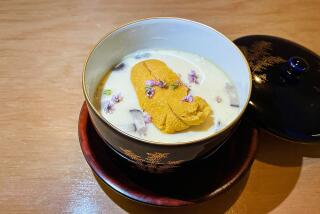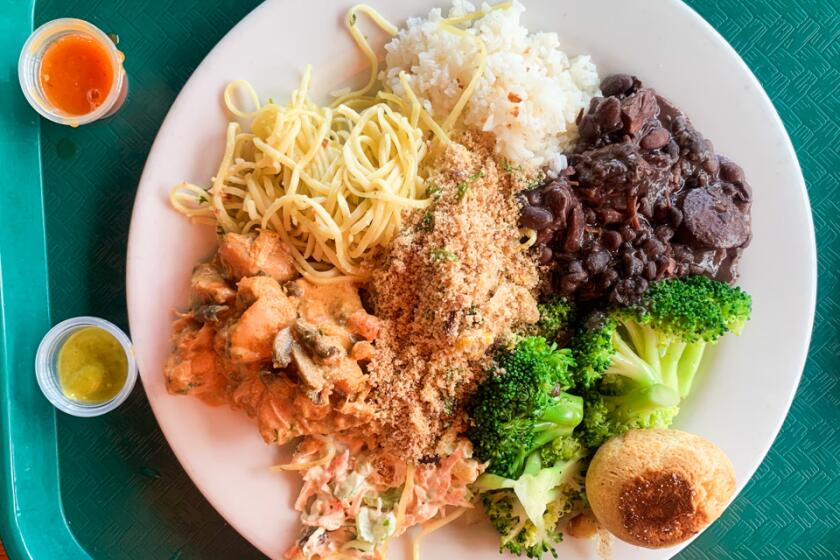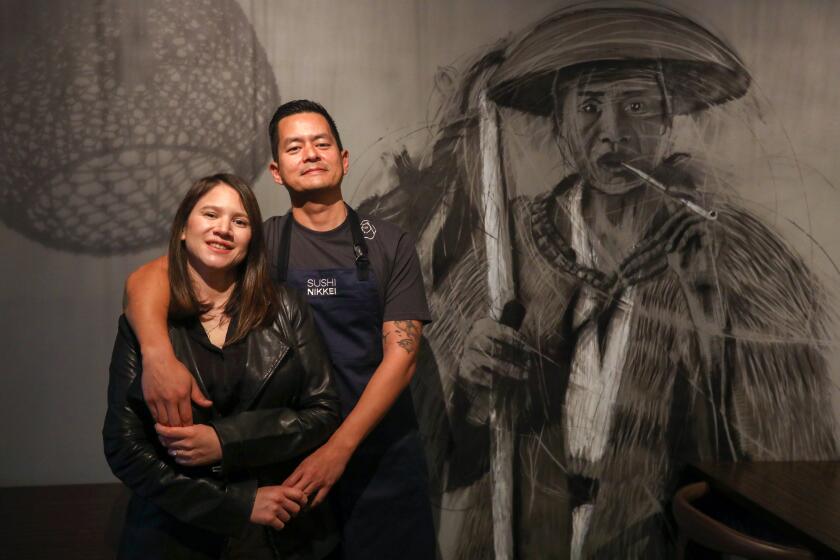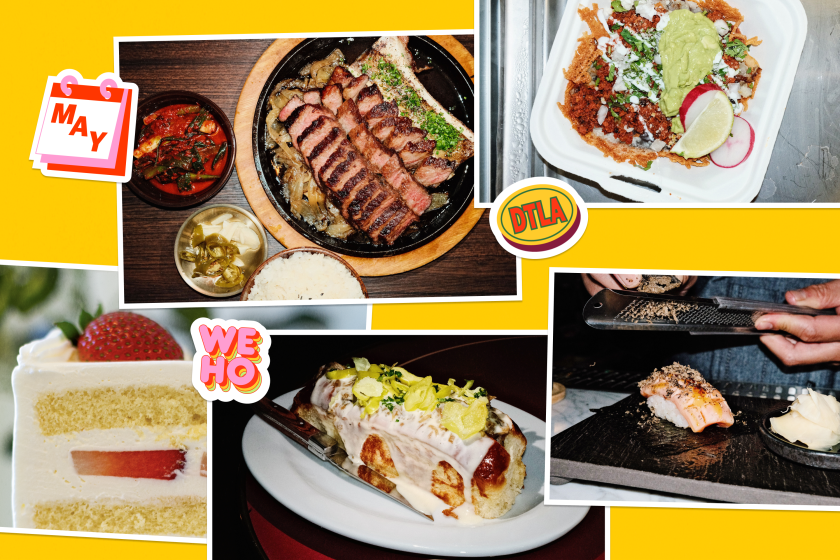Jonathan Gold | L.A. restaurant review: Purist <i>omakase</i> sushi at Zo
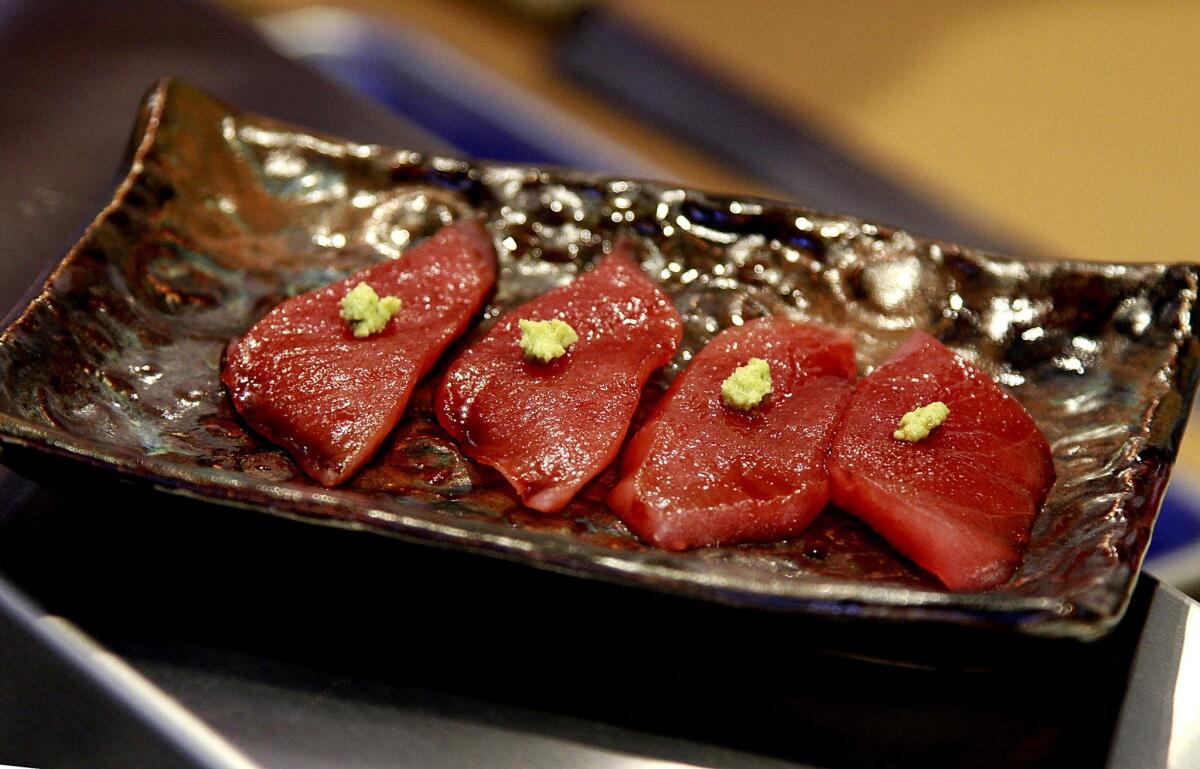
We have talked before about the gentrification of deep downtown, the colorful area familiar from dystopian novels and Tom Waits lyrics that has become the most reliable destination in town for bespoke cocktails, vintage party dresses and monogrammed dog bowls. And among the incongruous and wonderful things to have opened near the newly scrubbed corner of 4th and Main, that former nexus of flophouses and all-night porn theaters, none may stick out more than Zo, the new downtown sister to the Westside’s Sushi Zo, which serves $145 omakase tasting menus in a neighborhood that has not completely shrugged off its aura of loosies and cheap wine.
That $145 omakase menu, by the way, isn’t an exotic outlier noted for the purpose of a cheap metaphor — it is the only meal Zo serves. The person who picks up the phone when you call to make a reservation makes sure you know what you’re getting into. The person who greets you at the door of the brightly lighted restaurant looks at your shoes. And in the course of an evening at the restaurant, you are unlikely to see anyone just drop by.
The chef, possibly founder Keizo Seki, will ask if you have any seafood allergies when you settle in at the counter, and you will be handed a list of beer and sake, but when you enter the restaurant you have agreed to vote the straight Zo ticket. Los Angeles is famous for its inflexible itamae, but Seki is the first chef to bring the rigorous aesthetic to this side of town.
You may be familiar with the take-no-prisoners omakase menu in L.A. sushi restaurants, starting with the original Sushi Nozawa in Studio City, continuing with Sasabune and perhaps reaching its peak at the notorious (and wonderful) Hiko Sushi in Mar Vista.
Omakase meals have always been part of the good sushi chef’s repertoire — he, after all, knows more about the provenance of the fish than his patrons possibly could — but these places, as well as the original Sushi Zo, served only prescribed sushi in a prescribed order, removed the pitchers of soy sauce from their counters and often publicly shamed customers who dared ask for California rolls or spicy tuna or anything else that may not have been in the classic Edo-era repertoire. Some sushi chefs see education as part of their job, teaching their customers why oily fish are tastier in the winter or why one cut of tuna might be tastier than another, but this new breed of chefs just prepared and served their sushi, often at an incomprehensible pace, seeking to dazzle their patrons rather than enlighten them, winning them over with a cascading procession of freshness and taste.
Perhaps coincidentally, all of these places served sushi prepared in what I have come to think of as the Los Angeles style: longish slices of nursery-soft seafood draped over small lozenges of rice that are warm where you would expect them to be cool; washed with ponzu, pure yuzu juice or other sauces instead of just soy; and very, very lightly seasoned with freshly grated wasabi, the expensive root that gives sushi its pungency. Sushi Nozawa may have been famous for its specials chalkboard that read “Trust me,” but the Los Angeles style may imply instead: “I don’t trust you.”
Seki is as much of a purist as anyone in town. The seafood on his sushi is always soft, including normally crunchy things like octopus, which has been steamed to a kind of cushiony tenderness, and orange clam, which has been worked over with a knife to the point where you could probably eat it with a spoon. His rice is not just warm but actually hot, seasoned with vinegar to a point where it acts more as a condiment than as a starch, and rolled into tiny, loose-packed marbles that threaten to fall apart when you pick them up with chopsticks but miraculously never do.
He is working within a tradition, but his fans could pick his sushi out of a police lineup seven times out of eight, and even the sushi freaks who would rather spend their bonus money at Shunji or Kiyokawa (I probably count myself among them) admire the integrity of his cuisine.
You start at Zo with a Kumamoto oyster moistened with a sweetish ponzu sauce, then a few slices of butter-soft big-eye tuna sashimi (he intelligently disdains the threatened bluefin), and then an expertly dissected farmed baby abalone in its shell. There will be squid cut into a small heap of tender linguine and tossed with uni and a blast of truffle salt. A quick sunomono course will probably include chilled jellyfish with dabs of miso in a mild vinaigrette.
And then comes the sushi, up to 25 pieces in all, one after the other on attractive pottery, dealt so quickly that it is often hard to tell one from the next: halibut with lemon and a blast of grated sea salt; pink Oregon albacore with lime; mirugai clam with a splash of soy sauce; a meaty sliver of golden-eye snapper; a bit of chu-toro, big-eye tuna belly that somehow has the smack of fresh cream. If you have arrived at the counter at the same time a big table is being served, you may be surprised to see the chef preparing 10 orders at once, as casually as a Las Vegas dealer might flip out a hand of blackjack.
Am I going to tell you that your scallop is going to be so fresh that it is still wiggling when it hits your mouth; that the ankimo, monkfish liver, is going to be served hot; or that the black cod may be seared and dabbed with mayonnaise? Perhaps, perhaps not — the fish do change from day to day. The buri may be garnished with curled shavings of roasted shishito peppers; the giant clam may come with minced shiso.
The penultimate course will always hold one piece of sushi made with delicate, washed salmon roe and another with triple-decked San Diego sea urchin, except when Hokkaido uni is in season. There will be a final hand roll of finely chopped tuna, with which you will be allowed your one go at a dish of soy sauce … and then a tiny cordial glass half-filled with sweet, fresh yuzu juice. You are on the street before you know it. It is time to look for your car.
Purist sushi downtown — no questions asked.
LOCATION
334 S. Main St., Los Angeles, (213) 935-8409
PRICES
Set course omakase menu only, $145 per person
DETAILS
Lunch, noon to 2 p.m. Mondays to Fridays; dinner, 6-9:30 p.m. Mondays to Saturdays. Credit cards accepted. Beer, wine and sake. Street parking.
More to Read
Eat your way across L.A.
Get our weekly Tasting Notes newsletter for reviews, news and more.
You may occasionally receive promotional content from the Los Angeles Times.

